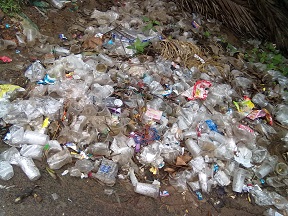Last week, the UNESCO building in Paris hosted a conference on putting an end to plastic waste. Long overdue, according to many delegates. Science Magazine proposed to cap global plastics production – and then reduce it step by step, in the years to come. Many fear that major plastics produces like the US, China and Saudi Arabia will only approve of better recycling. But the need to come into action is generally felt.

Plastic waste, a major problem
Global production rose rapidly. Since the 1950s, production rose by over 18,000 percent. In 2019 the world produced 368 million tons, one million tons per day. A major part of the production will end up in the environment. According to Naïm Derbali, about eighty percent of plastic products will end up in the bin within a year. Of that volume, just 9% is being recycled. Almost half is being landfilled, and 19% is incinerated.
The remaining 21% will end up in the environment. There, it is broken down, but very slowly so. First, it will produce micro and nano particles. If these float in water, they can be absorbed by living creatures. More than 2,100 species experience their negative consequences. Coral reefs and mangrove coastal areas suffer most from plastic waste. If micro particles end up in fish, they will also end up in humans. It may take a full thousand years for a plastic bottle to be decomposed entirely in nature. And there are very many kinds of plastic. They contain as many as 13,000 chemicals. Of which probably some 3,000 pose a threat to human health.
Recycling plastics is the option of choice of petrochemical industries and major parts of the business community. But recycling is problematic. Plastic quality will soon deteriorate; therefore, we always need to add some fresh plastics to the recyclate. And at the moment, just a tiny bit of all plastics is being recycled.

Plastic’s benefits
And yet, plastics carry a lot of benefits. They are versatile and easy to use; they live long, are cheap and wrap well vulnerable products. Of course, food, but electronics as well. At the same time, the Earth is being flooded with plastic waste. Plastic particles have been found in the most remote areas of the world – high in the Himalayas and deep in the troughs of the Pacific.
It is high time for a coordinated action against plastic waste. That was the subject of last week’s conference in Paris. In her opening speech, UNEP chairwoman Inger Andersen made a plea for ‘a total market transformation that drastically reduces the influx of new plastics…. We are here together because the linear plastic economy produces a plethora of pollution…. Plastics suffocate ecosystems, heat up the climate and impacts human health. And people in developing countries are those most affected.’
A major global problem
Plastic pollution is one of our planet’s major problems, comparable to climate and biodiversity problems. On the climate, the world concluded the Paris Agreement in 2015. On biodiversity, it concluded the Montreal Agreement in 2022, and recently the Ocean Treaty. But plastic pollution – environmental pollution in general – proves to be a much harder problem.

Climate change and biodiversity are global problems, first and foremost; plastic pollution is a local problem, primarily. Even though we cannot solve this problem just locally. Moreover, nobody makes a plea for a ban. The material is too useful – even a very good alternative from an environmental point of view. Plastic bottles as a packaging for liquids are much lighter than glass; and electricity cables can best be covered with plastics. But then, there are many plastics applications that testify to laziness. Like plastic coffee cups. We would manage very well without them. But each year, the world uses 250 billion disposable cups, just for coffee.
But for the time being, the use of plastics does not fall – on the contrary. Based on today’s trends, in 2060 we will dispose of three times as much plastic waste as we do today.
The plight of the developing countries
The most pressing problems with plastic waste appear in developing countries. On this site, we wrote about the rivers in Java that get clogged with plastic waste. And then, Bangladesh suffers severely from pollution of the Buriganga, the ‘old Ganges’. Scientists look upon the Buriganga as ‘biologically dead’. Leather works, clothes’ factories and industries discharge on the river. Putting a halt on such practices doesn’t seem to be a priority to the authorities.
On top of that, we now witness the export of plastic waste to developing countries. Until a few years ago, most waste plastic went to China. But in 2018 the Chinese government suddenly put an end to those practices. Since that time, much plastic ends up in other Asian countries. For instance, the EIA calculated in their report The Truth Behind Trash (2021) that Malaysia imports about 835,000 tons of plastic waste yearly – and produces 2.4 million tons itself. But its recycling capacity amounts to just 515,000 tons. In short: the remainder will end up in landfills. Stopping plastic pollution looks like an almost impossible task.
But then, after all…
But change may be around the corner. The recent Paris conference is the second one in a series of five. In 2024, this series should lead to an international agreement. According to UNEP chairwoman Andersen, recycling isn’t a viable option. Based on present agreements, recycling will reduce plastic pollution by just 8 percent in 2040. The conference’s goal is to reach a zero-waste agreement, a legally binding treaty that will put an end to all plastic pollution – already in 2040. A gigantic task, in a market that is still growing.
Another question is how to stop the illegal trade in plastic waste. According to the Environmental Investigation Agency (EIA), a British-American organization that investigates environmental crime, major volumes of plastic waste are being shipped around the globe – illegally, often. Just the EU exports some $ 15 billion worth of plastic waste, yearly.
Plastic waste – what we can do about it
NGOs come up with solutions. IPEN, the International Pollutants Elimination Network, that did extensive research into plastic waste, makes plea for a more careful treatment of the waste, for an export ban for plastic waste (to developing countries) and also for a ban on toxic additives to plastics. The World Wildlife Fund makes a plea for charging buyers with the real costs of plastics. Which, according to WWF, are about ten times the actual prices. That will stimulate alternatives as well.
Of course, conflicts of interest complicate an agreement as well. Developing countries hold rich countries responsible for the problem they are faced with and issue a bill for solving those problems. Industry, for its part, opposes strict environmental norms, and with some success.
Success after all?
But within the limits of reasonable expectations, the Paris conference had some success. The chair was given the assignment to formulate a draft treaty. Which will be discussed in Nairobi, by the end of this year.
‘Plastics have been the easy option for too long,’ says Inger Andersen. ‘It is high time for chemists, producers and engineers to become creative. It is high time for governments to become creative. It is high time for consumers to become creative.’
Interesting? Then also read:
The role of chemistry in the reduction of plastic waste
Closing the plastic loop
Tetraethyl lead, the scandal that never erupted
